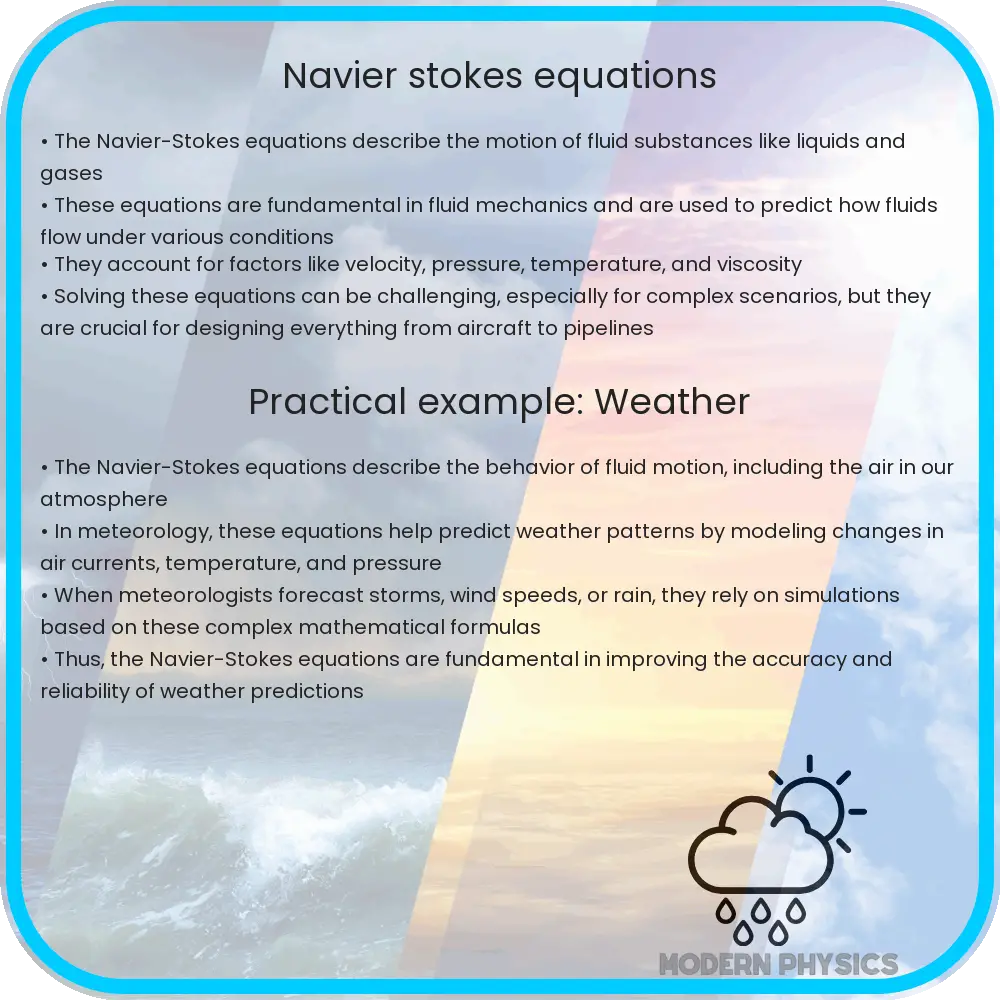Explore the Navier-Stokes equations in fluid dynamics: from basic principles to advanced applications in engineering, environment, and research.

Understanding the Navier-Stokes Equations in Fluid Dynamics
The Navier-Stokes equations are a set of partial differential equations that describe the motion of fluid substances such as liquids and gases. These equations are fundamental in the field of fluid dynamics, offering critical insights into the modeling and analysis of fluid flow. The Navier-Stokes equations are named after Claude-Louis Navier and George Gabriel Stokes, who made significant contributions to fluid mechanics.
Core Principles of the Navier-Stokes Equations
At their core, the Navier-Stokes equations express the conservation of momentum and mass for fluid substances. They combine Newton’s second law of motion with the conservation of mass principle, underpinning the complex behavior of fluids in various scenarios, from the flow of water in pipes to atmospheric dynamics.
Mathematical Formulation
The general form of the Navier-Stokes equations can be expressed as:
ρ(\partialsub / &partial;t + u ⋅ ∇u) = -∇p + μ∇2u + f
Here, ρ denotes the fluid density, u represents the fluid velocity vector, p stands for the pressure, μ is the dynamic viscosity, and f symbolizes external forces acting on the fluid.
Applications in Fluid Dynamics
The Navier-Stokes equations are used to model a wide range of fluid flow phenomena. This includes laminar and turbulent flows, flow around objects, and even weather patterns in meteorology. They are pivotal in engineering for designing and optimizing systems involving fluid flow, such as pipelines, HVAC systems, and aerodynamic components in vehicles and aircraft.
Challenges in Solving the Equations
Solving the Navier-Stokes equations can be challenging due to their non-linear nature. In many practical situations, exact solutions are not feasible, and numerical methods such as Computational Fluid Dynamics (CFD) are employed. CFD uses algorithms and computational power to simulate fluid flow, providing approximate solutions to these complex equations.
The Navier-Stokes equations not only epitomize the complexities of fluid dynamics but also highlight the interplay between mathematics and practical engineering applications. Their study continues to evolve, offering deeper insights into the behavior of fluids in both natural and artificial environments.
Advancements in Navier-Stokes Equations Analysis
Recent advancements in computational techniques have significantly enhanced the analysis and application of the Navier-Stokes equations. High-performance computing and improved algorithms have enabled more accurate and efficient simulations, even in highly complex fluid flow scenarios. This progress is crucial in fields like aerospace engineering, where precise fluid dynamics modeling is essential for the design and safety of aircraft.
The Role of Navier-Stokes in Environmental and Geophysical Studies
The Navier-Stokes equations also play a vital role in environmental and geophysical studies. They are used to model ocean currents, river flows, and atmospheric dynamics, contributing to our understanding of climate change, weather forecasting, and environmental protection. Researchers rely on these equations to simulate scenarios like oil spills, air pollution dispersion, and natural disasters such as tsunamis and hurricanes.
Education and Research in Fluid Dynamics
In educational settings, the Navier-Stokes equations are a fundamental part of the curriculum for students in physics, engineering, and environmental science. Understanding these equations is essential for developing the next generation of scientists and engineers who will continue to push the boundaries of fluid dynamics research.
Future Directions
Looking ahead, the exploration of the Navier-Stokes equations is poised to intersect with emerging fields such as nanotechnology and biomedical engineering. Innovations in these areas could lead to new applications, such as targeted drug delivery systems and the design of microfluidic devices.
Conclusion
The Navier-Stokes equations, central to the study of fluid dynamics, have profoundly influenced various scientific and engineering disciplines. Their application spans from designing sophisticated aerospace technologies to predicting environmental phenomena. Despite the complexity and challenges in solving these equations, ongoing advancements in computational methods continue to unlock new possibilities and insights. As technology evolves, the Navier-Stokes equations will remain a cornerstone in the understanding and manipulation of fluid behavior, driving innovation and discovery across multiple fields.
